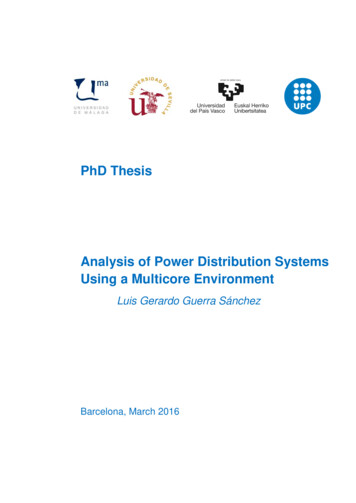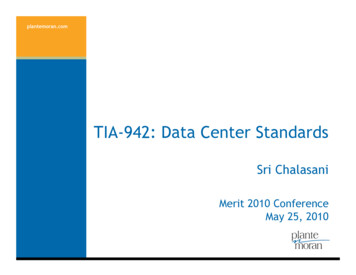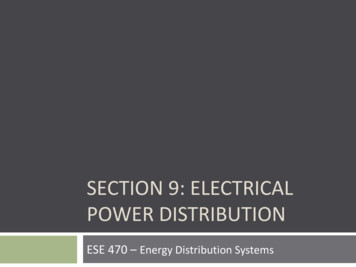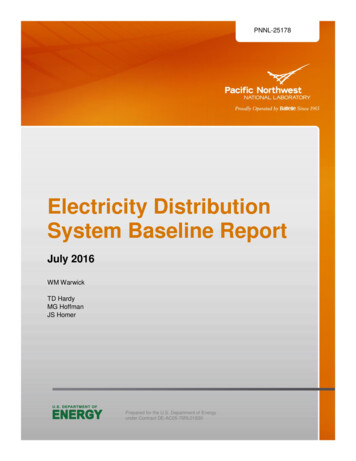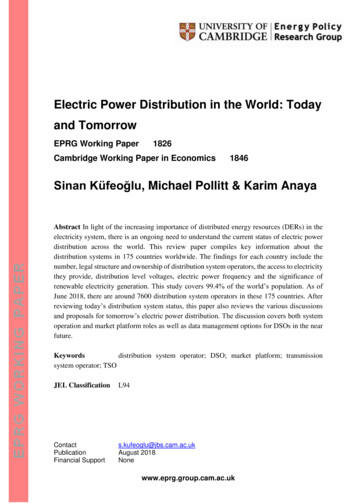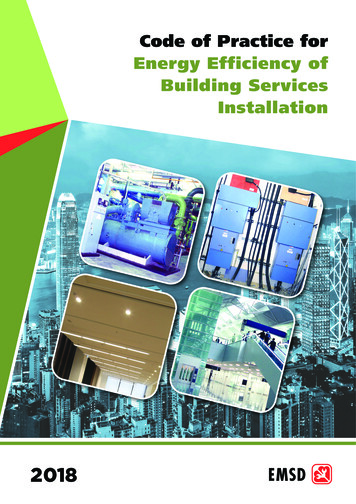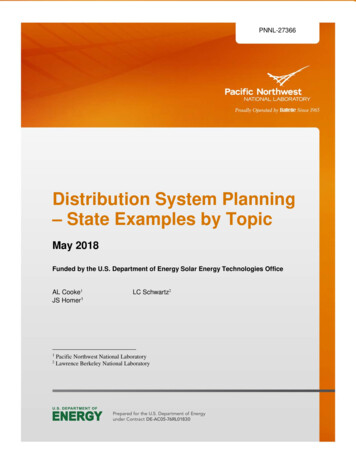
Transcription
PNNL-27366Distribution System Planning– State Examples by TopicMay 2018Funded by the U.S. Department of Energy Solar Energy Technologies OfficeAL Cooke1JS Homer112LC Schwartz2Pacific Northwest National LaboratoryLawrence Berkeley National Laboratory
PNNL-27366Distribution System Planning – StateExamples by TopicFunded by the U.S. Department of Energy Solar Energy Technologies OfficeAL Cooke1JS Homer1LC Schwartz2May 2018Prepared forthe U.S. Department of Energyunder Contract DE-AC05-76RL01830Pacific Northwest National LaboratoryRichland, Washington 9935212Pacific Northwest National LaboratoryLawrence Berkeley National Laboratory
Executive SummaryThe purpose of this report is to summarize approaches or elements of electric distribution system planning(DSP) that some states have adopted in the context of grid modernization and higher levels of distributedenergy resources (DERs). Other states can consider adapting these to help achieve the specific aims setfor their own DSP process. Table ES.1 lists state approaches to DSP that are described in this report.Table ES.1. State Approaches to Electric Distribution System Planning Washington 2underwayRequirement to summarize current practice Voluntary distribution or grid modernization plans supporting surcharge/rider cost recoveryImproved alignment / linking processes *Required reporting on poor-performing circuits and improvement plans is used to indicate the planning approach is applicable under the present regulatory or statutory requirements.* is used to indicate that the planning approach would apply under pending proposals or proposed decisions.1Rhode IslandPennsylvania OregonMichigan OhioMaryland Indiana* IllinoisNew York FloridaMinnesota Other States' ApproachesD.C.MassachusettsDistribution system plan requirement1Grid modernization plan requirementIncentives reflecting locational valueHosting capacity analysis requirementNon-wires alternatives requirementsStandardized calculations / processesStorm hardening requirementsNo planning requirement but proceedingHawaiiPlanning ApproachesCaliforniaStates WithAdvanced Practices ** Requirements for one or more utilities.2States noted in this row have processes underway which may result in adoption of one or multiple planning approacheslisted in this table.The report contains descriptions of and links to: Vision statements, goals, objectives, and definitions set by states to guide their distribution planningprocesses Materials that can potentially be adapted and used — for example, utility surveys and non-wiresalternatives (NWA) screening criteria Advanced tools, such as hosting capacity and locational net benefits methodologies, that can beadapted and usediii
Processes such as utility filing requirements — for example, distribution investment plans — that canshine light on DSP-related needs Cost recovery mechanisms that can incentivize grid improvements to improve reliability andresilience and modernize the grid Examples of how states are aligning distribution system planning with other types of planning.The first step for any state that wants to move forward with an integrated DSP process1 is to clearlydefine its vision, goals, and objectives. Clear goals and objectives will help guide the process and avoidwasted effort. Goals and objectives should take into account immediate needs and opportunities andthose that are likely to emerge in the future.1ICF 2016iv
AcknowledgmentsThe authors wish to acknowledge the valuable questions and guidance provided by Elaine Prause andother staff at the Oregon Public Utility Commission. This work was made possible by funding from theU.S. Department of Energy Solar Energy Technology Office (SETO) as part of a program to provideanalytical support to state public utility commissions. Special thanks to Michele Boyd, Elaine Ulrich, andGarrett Nilsen at SETO. The authors also wish to acknowledge that this project builds on a previous effortfunded by the U.S. Department of Energy’s Office of Electricity Delivery and Energy Reliability Electricity Policy Technical Assistance Program, and the Office of Energy Efficiency and RenewableEnergy - Solar Energy Technologies Office, through DOE’s Grid Modernization Initiative. We wish tothank Joe Paladino and Elaine Ulrich at DOE for their support with the foundational report along with coauthors Greg Leventis from Lawrence Berkeley National Laboratory and Francisco Flores-Espino andMichael Coddington from National Renewable Energy Laboratory. Internal review and editing wereprovided by Lindsay Steele and Cary Counts.v
Acronyms and AbbreviationsBGEBaltimore Gas & ElectricCPUCCalifornia Public Utilities CommissionDERdistributed energy resourcesDOEU.S. Department of EnergyDPUDepartment of Public UtilitiesDRPdistribution resource planningDSIPDistributed System Implementation PlanDSPdistribution system planningGMLCGrid Modernization Laboratory ConsortiumGMPGrid Modernization PlanGNAGrid Needs AssessmentGRCGeneral rate caseHECOHawaiian Electric CompaniesICCIllinois Commerce CommissionIOUinvestor-owned utilitiesIRECInterstate Renewable Energy CouncilIRPintegrated resource planningIURCIndiana Utility Regulatory CommissionLNBAlocational net benefits analysisMDPSCMaryland Public Service CommissionMIPSCMichigan Public Service CommissionNYPSCNew York Public Service CommissionNWAnon-wires alternativePUCPublic Utilities CommissionPUCOPublic Utilities Commission of OhioPVphotovoltaicRFPrequest for proposalTDSICtransmission, distribution, and storage system improvement chargeWUTCWashington Utilities and Transportation Commissionvii
ContentsExecutive Summary .Acknowledgments.iiivAcronyms and Abbreviations .vii1.0Introduction .1.12.0Context Matters .2.13.0Approaches .3.14.0Vision Statements and Goals for Distribution System and Grid Modernization Planning .4.15.06.0Distribution Investment Plans .Grid Modernization Plans .5.16.17.0Incentives Reflecting Locational Benefits .7.18.09.0Hosting Capacity Analysis .Non-Wires Alternatives .8.19.110.0 Standardization of Methodologies . 10.111.0 Storm Hardening . 11.112.0 Voluntary Planning and Surcharges to Accelerate Investment . 12.113.0 Aligning Distribution System Planning With Other Types of Planning . 13.114.0 Reporting on Reliability and Poor Performing Feeders . 14.115.0 Conclusion . 15.116.0 References . 16.1ix
1.0IntroductionIn December 2017, the U.S. Department of Energy’s (DOE) Grid Modernization Laboratory Consortiumcompleted a study on how utility regulators in 16 states have addressed distribution system planning(DSP) in the context of grid modernization and higher levels of distributed energy resources (DERs).6 Thestudy catalogued extensive information on state-level activities related to DSP and grid modernizationplans, including tools for integrating DERs, such as hosting capacity and locational value analyses, andlinkages to related processes, such as cost recovery through general rate cases or rate surcharges.Oregon is among the states included in the report, with several proceedings completed, underway andunder consideration related to DSP. To advance this work, the Oregon Public Utility Commission(Commission) requested assistance from DOE’s Solar Energy Technologies Office on DSP. In responseto this request, the Pacific Northwest National Laboratory (PNNL) and Lawrence Berkeley NationalLaboratory (Berkeley Lab) identified 1) specific topics from the original study of particular interest tostates such as Oregon and other states moving toward comprehensive DSP and 2) states that couldprovide potential examples to draw from. Toward that end, this report summarizes and reorganizes thepertinent original material by subject. We developed a table that points to specific states for each topic.The “Approaches” section calls attention to a few immediately useful documents. The body of this reportincludes summaries of each state example by topic area with web links to the source documents. Somestates have taken significant steps since information was collected for the original Grid ModernizationLaboratory Consortium study. In these cases, we have supplemented the original information.Depending on context, needs and opportunities within a state, potential benefits of a more integrated andtransparent DSP process include: Comprehensive utility plans for distribution-level investments that signal intended acquisitions over alonger time horizon, before they show up individually in cost recovery proceedings. Strong links between DSP and other planning activities to establish distribution system resources asoptions to meet bulk system needs. Improved forecasting and representation of DER in distribution plans and other utility plans. Valuation of DERs to inform more granular compensation by type and location. A roadmap for optimized locational planning for DERs, including implementation of hosting capacityand locational value analysis. Opportunities for meaningful public utility commission (PUC) and stakeholder engagement, whichcan improve outcomes.This report identifies how some states have addressed these issues. It provides examples that other statesmay find useful.6Grid Modernization Laboratory Consortium. 2017. State Engagement in Electric Distribution System Planning.PNNL-27066. Prepared by Homer, J. and A. Cooke (Pacific Northwest National Laboratory), L. Schwartz and G.Leventis (Lawrence Berkeley National Laboratory), and F. Flores-Espino and M. Coddington (National RenewableEnergy Laboratory), prepared for the U.S. Department of Energy.https://epe.pnnl.gov/pdfs/State Engagement in Electric Distribution System Planning PNNL 27066.pdf1.1
1.2
2.0Context MattersUtility regulators in many states are grappling with questions related to electric DSP in the context of gridmodernization and increasing levels of DERs. State Engagement in Electric Distribution System Planningreviews DSP and related activities in 16 states. States adopt different requirements for planningdistribution systems based on the context in which the regulator is working. For example, states with lowpenetrations of rooftop solar are less likely to require utilities to pursue hosting capacity analyses thanstates with high penetrations. Thus, the context in which the regulator is working is an important factor inimplementation of planning activities.Context-specific factors that should be considered in DSP include (GMLC 2017a): Statutory requirements and regulatory requirements; Priorities, phasing and related proceedings; and Differences across utilities.2.1
3.0ApproachesTable 1 summarizes approaches or elements of DSP that some states have adopted and that other statesmight consider.1 Five of the states in Table 1, “States with Advanced Practices,” are among the first toestablish a systematic and comprehensive approach to DSP or grid modernization, and also havedeveloped advanced practices for addressing higher levels of DERs. Another 11 states are included torepresent a broader array of approaches to DSP.Table 1. State Approaches to Electric Distribution System Planning Washington 2underwayRequirement to summarize current practice Voluntary distribution or grid modernization plans supporting surcharge/rider cost recoveryImproved alignment / linking processes *Required reporting on poor-performing circuits and improvement plans is used to indicate the planning approach is applicable under the present regulatory or statutory requirements.* is used to indicate that the planning approach would apply under pending proposals or proposed decisions.1Rhode IslandPennsylvania OregonMichigan OhioMaryland Indiana* Illinois FloridaNew York Other States' ApproachesD.C.Minnesota MassachusettsDistribution system plan requirement1Grid modernization plan requirementIncentives reflecting locational valueHosting capacity analysis requirementNon-wires alternatives requirementsStandardized calculations / processesStorm hardening requirementsNo planning requirement but proceedingHawaiiPlanning ApproachesCaliforniaStates WithAdvanced Practices ** Requirements for one or more utilities.2States noted in this row have processes underway which may result in adoption of one or multiple planning approacheslisted in this table.Some highlights of these approaches are listed below. California is rolling out a series of processes and requirements that fit together into an integrateddistribution resource planning (DRP) process. The DRP process includes an assessment of DERs(including load and hosting capacity calculations, locational value assessments, and DER growthscenarios), an assessment of grid needs, frameworks for grid modernization investments and1The report State Engagement in Electric Distribution System Planning (December 2017) contains a table (Table S1) that is similar in format. Table 1 here is not intended to replace the original; rather, it is intended to help identifywhere utility regulators might look for examples to consider as they move forward.3.1
investment deferrals and a solicitation process for DERs. The California PUC’s latest order on gridmodernization is located here (CPUC 2018a). Maryland Public Service Commission required utilities (see item 90 in the case file located here) tosubmit five-year distribution plans describing how the utilities will prioritize distribution resourcesover the five-year period (MDPSC 2016b, page 58). Baltimore Gas & Electric’s (BGE) 2017 filing(BGE 2017) is an example (item 116 located here). The Minnesota Public Utilities Commission issued a questionnaire (located here) to collectinformation a) from utilities about their distribution planning processes and current plans and b) fromboth utilities and stakeholders on ways to improve or augment the utilities’ DSP processes (MNPUC2017). The New York Public Service Commission (NYPSC) directed utilities in their initial DistributionService Platform Provider filings to present information about the state of their distribution systems,planning processes, and specific system needs to build and maintain distribution service providerfunctions. Subsequent filings are geared toward common approaches to completing the process ofdefining how the utilities will transform their systems to become Distribution Service PlatformProviders as envisioned by the Commission. The Commission order (NYPSC 2016b) can be foundhere. Two states, Hawaii and Massachusetts, required utilities to submit Grid Modernization Plans (GMP).In contrast to modernization plans that simply look at including smart grid assets, the required plansalso must include modern planning methods, such as identifying how DERs can be used to strengthenand add to the reliability of the grid, and advanced systems for controlling distribution systems.oHawaii – For Hawaii’s order with guidance on plan contents, see Hawaii Public UtilityCommission 2017a, pp. 50–66, located here.oMassachusetts – For Massachusetts’ order with guidance on plan contents, see MassachusettsDepartment of Public Utilities (DPU) 2014, pages 2–6 located here. Four states (Illinois, Indiana, Ohio, and Pennsylvania) have statutes allowing utilities to request ratesurcharges to recover distribution investments if they file distribution plans (voluntary plans). Five states (Florida, Illinois, Ohio, Pennsylvania, and Rhode Island) have requirements for reportingon poorly performing circuits and filing improvement plans. Florida and Ohio are discussed later inthis report. Three states (Washington, Minnesota, and Rhode Island) are examining the alignment of planningprocesses, such as IRP and DSP, or synchronizing multiple separate planning processes. DOEsponsored a report for the Minnesota Public Utilities Commission commissioned, located here, that isinformative in this regard (ICF 2016).3.2
4.0Vision Statements and Goals for Distribution System andGrid Modernization PlanningClear vision statements, goals, objectives, and definitions are important for distribution system and gridmodernization planning. Borrowing loosely from the impetus for action in Minnesota (GMLC 2017b,page 4.1), common reasons for engaging in these processes as articulated by many states include that thedistribution grid is at an inflection point because of DER; with rapid changes in the types of DER anddeclining costs, utilities and states should enable customer choices; and the processes of the past will notwork going forward, and now is the time to invest in the 21st century grid. California – The California Public Utilities Commission defined grid modernization in a recentdecision:1 “A modern grid allows for the integration of DERs while maintaining and improving safetyand reliability. A modern grid facilitates the efficient integration of DERs into all stages of DSP andoperations to fully utilize the capabilities that the resources offer, without undue cost or delay,allowing markets and customers to more fully realize the value of the resources, to the extent costeffective to ratepayers, while ensuring equitable access to the benefits of DERs. A modern gridachieves safety and reliability of the grid through technology innovation to the extent that is costeffective to ratepayers relative to other legacy investments of a less modern character.”(CPUC 2018a, page 7). Maryland – In September 2016, the Maryland Public Service Commission (MDPSC or Commission)initiated Public Conference 44 (PC44) “ to ensure that electric distribution systems in Maryland arecustomer-centered, affordable, reliable and environmentally sustainable.” The MDPSC adopted avision statement in 2017 and identified several topic areas to be addressed by workgroups led by aCommission Advisor (MDPSC 2017, pages 12–14). The vision statement is an early step in theprocess. (GMLC 2017b, page 10.1). Minnesota – The Minnesota Legislature required Xcel Energy to file grid modernization plans everytwo years. The Commission provided early guidance through its decision on the initial plan (GMLC2017b, page 4.3) as well as a Staff report that teed up three questions:–“Are we planning for and investing in the distribution system that we will need in the future?”–“Are the planning processes aligned to ensure future reliability, efficient use of resources,maximize customer benefits, and successful implementation of public policy?”–“What Commission actions would support improved alignment of planning for and investment inthe distribution system” (MNPUC 2015, page 12)? New York – The NYPSC is redefining what it means to be a distribution service provider. Asenvisioned by the NYPSC, it is “ an intelligent network platform that will provide safe, reliable andefficient electric services by integrating diverse resources to meet customers and society’s evolvingneeds. The distribution service provider fosters broad market activity that monetizes system andsocial values by enabling active customer and third-party engagement that is aligned with thewholesale market and bulk power system.” (NY PSC 2015a, page 31). The Commission’s Track I1The CPUC decision was issued in 2018, after the December 2017 publication of DOE’s report upon which muchof this report based.4.1
Order described the goals of the Distributed System Implementation Plan (DSIP) (GMLC 2017b,page 5.1):–Serve as a source of public information regarding distribution service provider plans andobjectives, including specific system needs allowing market participants to identify opportunities–Serve as the template for utilities to develop and articulate an integrated approach to planning,investment, and operations–Enable the Commission to supervise the implementation of Reforming the Energy Vision in thecontext of system operations (NY PSC 2015a, page 129; GMLC 2017b, page 5.1). Rhode Island – Known as the Power Sector Transformation Initiative, Rhode Island’s gridmodernization initiative has three objectives: 1) control long-term costs of the system, 2) providemore energy choices for customers, and 3) build a flexible grid to integrate more clean energygeneration (R.I. DPUC, OER, & PUC. 2017. 2017, pages 8–9). DSP is one of four work streams.2This work stream is considering what outcomes should be promoted by DSP, what aspects of utilityoperations it should address, and how accessible planning should be to third parties (GMLC 2017b,page 15.1).2The other three work streams are utility business models, grid connectivity functionality, and electrification oftransportation and heating.4.2
5.0Distribution Investment PlansCalifornia and New York require utilities to routinely file distribution investment plans. These plans maketransparent the methods used and generally provide visibility into the existing state of the systems andplanning process. Additionally, some states have taken phased approaches where they have ordered eitherinitial distribution system plans to be filed (Maryland, Michigan) or descriptions of the utilities’ currentdistribution system planning process (Minnesota). California – To implement legislation requiring utilities to consider nonutility-owned DERs in theirDSP, the California Public Utility Commission (CPUC) required investor-owned utilities (IOUs) tofile Distributed Resource Plans (DRPs). The CPUC order required utilities to consider locationalbenefits and costs of DERs on the distribution system, and to identify tariffs and other mechanisms todeploy cost effective DERs, ways to coordinate with other state DER incentive programs, additionalutility spending needed to integrate cost effective DERs, and barriers to deployment of DERs (DOE,2017, pages 1.1–1.2).In February 2018, the CPUC issued a decision giving greater direction to utilities. The IOUs are tofile annual Distributed Resource Plans and Grid Needs Assessments (GNAs) that identify specificdeficiencies on the distribution system. The GNAs are to form the basis for annual project lists forutility distribution work and shall document deficiencies quite specifically (e.g., identifying thecircuit, the deficiency the underlying cause of the deficiency such as meeting customer growth, etc.).The GNA is also the basis for a list of potential candidates for non-wires alternatives (NWAs)discussed in the NWA section of this report. The GNAs will also provide input to the utility’s GMP(as discussed in the next section of this report) and provide additional information to inform GRCs(CPUC 2018b). New York – As part of the New York Reforming the Energy Vision process, the NYPSC inDocket/Case 14-M-0101 ordered IOUs within the state to file DSIPs. The NYPSC specified filing toinvolve two or more phases:–In the first phase, each utility addressed its own system and identified immediate changes thatcould be made to effectuate state energy goals and objectives (filed June 2016). This filing alsorequired utilities to provide information regarding their current 5-year capital investment plans asa first step toward providing customers and other parties with the information needed to identifyand characterize near-term opportunities for DER development in each utility’s electricdistribution system (NYPSC 2016, page 24 and Attachment 1 to the order that specifies detailedinformation to be included).–In the second phase, utilities filed a joint—and as necessary, individual—Supplemental DSIPs(filed November 2016) that addressed the tools, processes, and protocols that would be developedjointly or under shared standards, and that would be used to plan and operate a modern gridcapable of dynamically managing distribution resources and supporting retail markets (NYPSC2016, pages 24–25).–In subsequent filings (on a biennial basis), utilities are expected to include more details (GMLC2017b, page 5.2).5.1
Maryland – The MDPSC wanted to ensure that the Potomac Electric Company (Pepco) and BGEfully used the smart grid technology they were installing and that ratepayers realize a demonstrablereturn on the investment—in particular the investment in advanced metering infrastructure. For thisreason, the MDPSC required Pepco (MDPSC 2016a, page 22) and BGE (MDPSC 2016b, page 58) tosubmit distribution investment plans (DOE, 2017, page 10.2).–In June 2017, BGE filed a distribution investment plan (BGE 2017).–In November 2017, Pepco filed an investment plan (Pepco 2017).–Both plans are relatively short, high-level summaries stemming from Commission orders ingeneral rate cases. Michigan – The Michigan Public Service Commission (MIPSC) ordered DTE Electric Company andConsumers Energy Company to develop and submit 5-year distribution plans in response to generalrate case proceedings. While authorizing the utilities to revise their rates, the MIPSC stated that itlacked the appropriate level of information to properly evaluate the investments in the utilities’distribution systems (GMLC 2017b, page 11.1).–The order issued by MIPSC stated they did not intend distribution plans to be formally approved.Rather, plans were to provide Staff, MIPSC, and other interested parties with “ a morethorough understanding of anticipated needs, priorities, and spending outside of the contested ratecase process.” (MIPSC 2017, page 2)–After reviewing the utilities’ draft filings, MIPSC clarified its expectations that in their finalfilings, utilities would focus on addressing aging infrastructure, identifying and addressing knownsafety concerns, identifying how to prioritize maintenance and investments to improve reliabilityand resilience, and defining objectives and metrics for meeting reliability goals (MIPSC 2017,pages 16–17). Minnesota – The Minnesota PUC used a questionnaire to assess the status of distribution planning inthe state and to improve the process moving forward. In April 2017, the Commission issued a Noticeof Comment Period and a questionnaire1 to inform the Commission and Staff on distribution planning(MNPUC 2017). PUC staff proposed draft rules in April 2018, in Docket 15-556, accessible here. Adecision on distribution planning requirements is expected in 2018 (GMLC 2017b, pages 4.3–4.4).1The Distributed Resource Plans mentioned in Section 4 of this report cover specific mechanisms for utilizing andguiding the locational development of DERs, while the Grid Modernization plans are seen as long-term planningvisions.5.2
6.0Grid Modernization PlansSeveral states have either passed legislation calling for or enabling grid modernization planning, or utilityregulators have ordered utilities to develop plans. In Hawaii and Massachusetts, regulators orderedjurisdictional utilities to develop comprehensive GMPs including metrics and methodologies for valuingDER and comparing NWA solutions to traditional solutions. Hawaii – Hawaii set a 100% renewable energy portfolio standard for 2045. Between high electricrates and policies encouraging the installation of solar PV, approximately 16% of customers inHawaii had rooftop solar systems in 2016 (GMLC 2017b, page 2.1). As a result, the Hawaii PublicUtilities Commission supports development of modern grids to support renewable energy and DERsin general. In Order No. 34281 (HPUC 2017a, pages 50–66), the Commission provided guidance fordeveloping a detailed, scenario-based grid modernization strategy that provides a comprehensive andholistic vision and context to inform subsequent review of discrete grid modernization projectapplications submitted by the utility (GMLC 2017b, pages 2.2, 2.5).–Hawaiian Electric Companies, or HECO (i.e., Hawaiian Electric Company, Inc., Hawaii ElectricLight Company, Inc., Maui Electric Company, Limited), filed a final Grid ModernizationStrategy on August 29, 2017 (HECO 2017).–HECO proposed a new planning process to integrate the customer, distribution, transmission andbulk power resource levels of the system. The process which HECO calls Integrated GridPlanning was filed with the PUC on March 1, 2018 (HECO 2018). Primary features of HECO’sproposal include: 1) extensive customer and stakeholder involvement; 2) holistic, optimizedsolutions for resource adequacy and grid services, based on procurement processe
BGE Baltimore Gas & Electric . CPUC California Public Utilities Commission . DER distributed energy resources . DOE U.S. Department of Energy . DPU Department of Public Utilities . DRP distribution resource planning . DSIP Distributed System Implementation Plan . DSP distribution system
